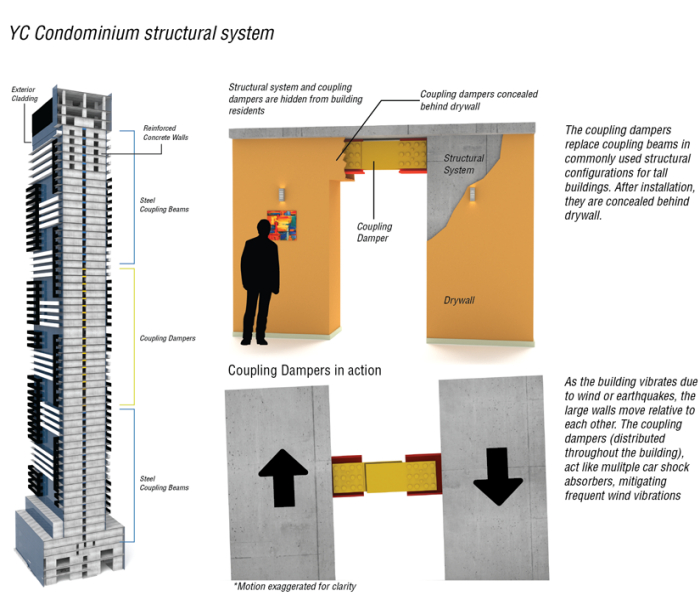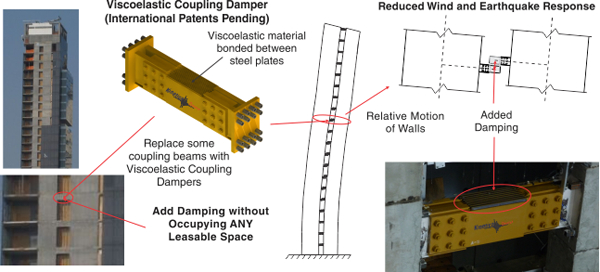A Toronto-based engineering company is going global with an innovative new damping system that holds great potential for skyscraper construction. Kinetica, an engineering firm specializing in damping and isolation technologies, has released details on its new Viscoelastic Coupling Damper (VCD) which can be integrated into new buildings to provide resistance to heavy wind loads and earthquakes. The new system will be incorporated in Canderel's upcoming YC Condos at Yonge and College, as well as being distributed in China, fresh off a new deal signed earlier this month as part of Kathleen Wynne's trade talks in that region.
 Image of the VCD undergoing testing in Kinetica's lab, image by Craig White.
Image of the VCD undergoing testing in Kinetica's lab, image by Craig White.
The VCD system is a simple solution that offers many benefits for tall and supertall skyscrapers. Damping systems are used to counter the effects of wind and seismic loads on tall buildings, which can sway up to several feet in either direction on the upper floors during a heavy wind storm. Current damping systems can be limiting in their use, either due to their space requirements, cost, or effectiveness in accommodating numerous loads.
While steel frame structures can more easily accommodate diagonal braces and supports for damping, concrete frame structures - an increasingly economical structural system - have no room in their solid, rigid frame to incorporate damping mechanisms. In these instances, mass dampers are employed, which usually consist of a large steel mass or tank of water located at the top of tall buildings that acts as a counter-weight to any strong lateral forces. Mass dampers, however, do not account for earthquake loads, and often occupy several storeys of usable floor area on the prime real estate of the upper levels.
Video showing dynamic testing of the VCD technology, video courtesy of Kinetica.
Kinetica aims to replace the standard of using mass dampers with VCD technology, providing a solution that can be integrated directly into the structure of the building, without taking up any leasable floor area on the valuable upper levels. A VCD replaces coupling beams in the shear walls of a concrete structure. Shear walls, usually located in the core of a building, are necessary to provide rigidity to a skyscraper to resist wind loading. However, programmatic elements often require openings to be cut into these walls, for access to elevators, services, and corridors. In these cases, the divided shear walls are connected by a concrete coupling beam, which ties the two walls together to maintain the core's rigidity. By replacing the concrete coupling beam with a Viscoelastic Coupling Damper, the structure can be made to resist heavy lateral loads and vibrations while maintaining the necessary rigidity of the core.
 A diagram showing the integration of VCDs into YC Condos, image courtesy of Kinetica
A diagram showing the integration of VCDs into YC Condos, image courtesy of Kinetica
The VCD is composed of viscoelastic polymer sandwiched between steel plates, and anchored at either end into the building's structure. VCDs absorb vibrations and lateral loads applied to the building and convert it into heat energy. Initially intended to resist wind loading, VCD technology was also found to be highly effective against seismic loads.
 A diagram of the composition and mechanism of the Viscoelastic Coupling Damper, image courtesy of Kinetica
A diagram of the composition and mechanism of the Viscoelastic Coupling Damper, image courtesy of Kinetica
Kinetica was founded in 2011 by Michael Montgomery, alumnus of University of Toronto's Civil Engineering program, and Constantin Christopoulos, professor at University of Toronto. The two have been working together for nearly 10 years studying viscoelastic dampers. Viscoelastic dampers were actually the first damping system used in skyscrapers dating back to the 1960s, and with the proliferation of concrete frame construction in recent years, Montgomery and Christopoulos felt the need to revisit the technology and streamline it for contemporary use. Now, four years after its founding, Kinetica is seeing its first chance to implement its VCD technology in the Graziani + Corrazza Architects-designed YC Condos, set for completion in 2017.
Kinetica was not alone in developing and marketing VCD technology, receiving help from organizations both locally and abroad. Kinetica worked closely with damper manufacturers Nippon Steel & Sumikin Engineering and 3M to ensure the design's feasibility, while financial and logistical support was offered through several grants and organizations associated with the University of Toronto.
 A rendering of YC Condos, which will integrate Kinetica's VCD technology, image courtesy of Canderel
A rendering of YC Condos, which will integrate Kinetica's VCD technology, image courtesy of Canderel
The VCD technology shows great promise for the future of tall buildings, a sight which we are all too familiar with here in Toronto. Montgomery and Christopoulos are excited to see the first use of VCDs in the upcoming YC Condos, and are optimistic with the opportunities presented by their recent trade deal with China. As Toronto towers continue to reach for the sky, Kinetica's homegrown innovations might start appearing more frequently both here and abroad, revolutionizing building technology for the future.
| Related Companies: | Egis, entro, Graziani + Corazza Architects, Rad Marketing, RJC Engineers, Ryan Design International |

 3.9K
3.9K 
















































